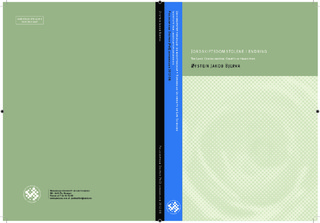| dc.contributor.advisor | Sevatdal, Hans | |
| dc.contributor.advisor | Falleth, Eva | |
| dc.contributor.advisor | Hegstad, Einar | |
| dc.contributor.author | Bjerva, Øystein Jakob | |
| dc.date.accessioned | 2017-03-03T08:29:12Z | |
| dc.date.available | 2017-03-03T08:29:12Z | |
| dc.date.issued | 2012 | |
| dc.identifier.isbn | 978-82-575-1045-9 | |
| dc.identifier.issn | 1503-1667 | |
| dc.identifier.uri | http://hdl.handle.net/11250/2432843 | |
| dc.description.abstract | The thesis focuses on changes in legislation and practice of the Land Consolidation Courts (LCC) in the period from the current Land Consolidation Act entered into force on 01.01.1980. The research is based on a document survey of court records, rulings and case documents as well as various reports and preparatory works. The sample of cases comprises a total of 283 claims handled by four LCC in respectively 1985 and 2005. Findings conclude that the LCC has changed from being an agrarian reformer - "the classic land consolidation" - to be a tool for most types of property and land rights. Its origin as a special court and an agricultural policy instrument is central to understanding and explaining the LCC development. Urbanization, social change and structural rationalization in agriculture have created new frameworks but also new responsibilities. Meanwhile, court reforms with the establishment of the Norwegian Courts Administration, and transfer of administrative responsibility of the LCC from the Ministry of Agriculture to the Court Administration has also been of significant importance. It has also been a period with many changes in the legislation with new Civil Proceedings Act, changes in the Planning and Building Act and the new Land Registration Act. Research shows that the overarching institutional framework has been of great importance for the LCC development. I have investigated the possibility for a discontinuity in the development of the LCC during this period, for example signaled by the transfer to the court administration. New tasks have been added to the original tasks. There is, however, a growing bias related to tasks such as boundary dispute resolution and land consolidation in urban areas. There are also a growing number of cases in which joint use and new land management organizations are the primary issues. The number of agricultural land rearrangements has decreased. The proceedings of the court have also been modernised and professionalised. Even though more changes in land use require permission from the public authorities, there are relatively few cases where a land consolidation court needs to ask for permission from public bodies. However, this is an area that may need closer regulation. Hopefully this thesis contributes to the discussion about development of the LCC courts. I would also argue that despite the many legislative changes there has not been a discussion about the more fundamental conditions for use of land consolidation. | nb_NO |
| dc.description.abstract | Avhandlingen fokuserer på endringer i jordskiftedomstolene i perioden fra gjeldende jordskiftelovs ikrafttreden 1.1.1980. Det empiriske grunnlaget er en dokumentundersøkelse av rettsbøker og saksdokumenter i saker behandlet av jordskiftedomstolene. I tillegg til bruk av lovforarbeider og utredninger om jordskifte og reformer i domstolene og tilknyttede systemer. Utvaget av saker er består av i alt 283 krav behandlet ved fire jordskifteretter i henholdsvis 1985 og 2005.
Jordskifte har i perioden endret seg fra å være en agrar reformator - ” det klassiske jordskifte” - til å være et redskap for alle typer eiendommer. Utgangspunktet som særdomstol og et landbrukspolitisk virkemiddel er sentral for å forstå og forklare jordskiftedomstolens utvikling. Denne utviklingen har preget debatten om jordskiftedomstolene i tidsperioden for denne undersøkelsen. Samfunnsendringer og strukturrasjonaliseringer i landbruket har skapt nye rammer for domstolen men også nye oppgaver. Landet er urbanisert, og dette har stor betydning for landbruket.
Samtidig har domstolsreformene med opprettelsen av Domstoladministrasjonen (DA) i 2006, og jordskiftedomstolenes overflytting fra Landbruksdepartementet til DA også vært av betydning. Det har i tillegg vært en omfattende lovutvikling i perioden, med ny tvistelov, endringer i plan og bygningsloven og ny matrikkellov. Min forskning viser at slike endringer i institusjonelle rammevilkår har vært av stor betydning for jordskiftedomstolens utvikling.
Jeg har stilt spørsmål ved om det har vært en diskontinuitet i utviklingen i jordskiftedomstolene. Det har det i liten grad vært. Nye oppgaver har kommet, men få har blitt borte. Det er fortsatt saker som gjelder landbrukseiendommer som dominerer arbeidet ved de fire domstolene i undersøkelsen. Saksbehandlingen i domstolen, både rettslig og teknisk, representerer kanskje den største endringen. Den har i perioden fra 1985 blitt sterkt profesjonalisert og modernisert, særlig som følge av teknologisk utvikling men også nye formelle krav. Samtidig har offentlig regulering i andre eiendomssystemer enn jordskifte grepet om seg. Flere tiltak som jordskifteretten før kunne beslutte gjennomført, krever nå tillatelse fra forvaltningsmyndighetene, eller er i utgangspunktet forbudt. Eksempler på dette kan være bygging av skogsbilveger og bakkeplanering. Til tross for dette er det relativt få saker hvor jordskiftedomstolen må søke tillatelse av forvaltningen.
Forholdet mellom jordskiftedomstolen og forvaltningsmyndighetene er imidlertid et område som kan behøve nærmere lovregulering Målet med avhandlingen er å bidra til kunnskap om hvordan samfunnsutviklingen, endringer i lovgivingen og jordskifterettens organisatorisk tilknytning har påvirket innholdet i jordskiftesakene og jordskiftedomstolenes utvikling. Forhåpentligvis vil avhandlingen bidra til diskusjon om særdomstolens samfunnsoppdrag og utvikling. Jeg vil hevde at det til tross for mange lovendringer og nye rammebetingelser så har det ikke vært en diskusjon om de mer grunnleggende spørsmålene om vilkårene for jordskifte. | nb_NO |
| dc.description.sponsorship | Domstoladministrasjonen | nb_NO |
| dc.language.iso | nob | nb_NO |
| dc.publisher | Norwegian University of Life Sciences, Ås | nb_NO |
| dc.relation.ispartofseries | PhD Thesis;2012:8 | |
| dc.rights | Attribution-NonCommercial-NoDerivatives 4.0 Internasjonal | * |
| dc.rights.uri | http://creativecommons.org/licenses/by-nc-nd/4.0/deed.no | * |
| dc.title | Jordskiftedomstolene i endring | nb_NO |
| dc.title.alternative | The land consolidation courts in transition | nb_NO |
| dc.type | Doctoral thesis | nb_NO |
| dc.subject.nsi | VDP::Social science: 200::Law: 340 | nb_NO |
| dc.source.pagenumber | 1 b. (flere pag.) | nb_NO |

